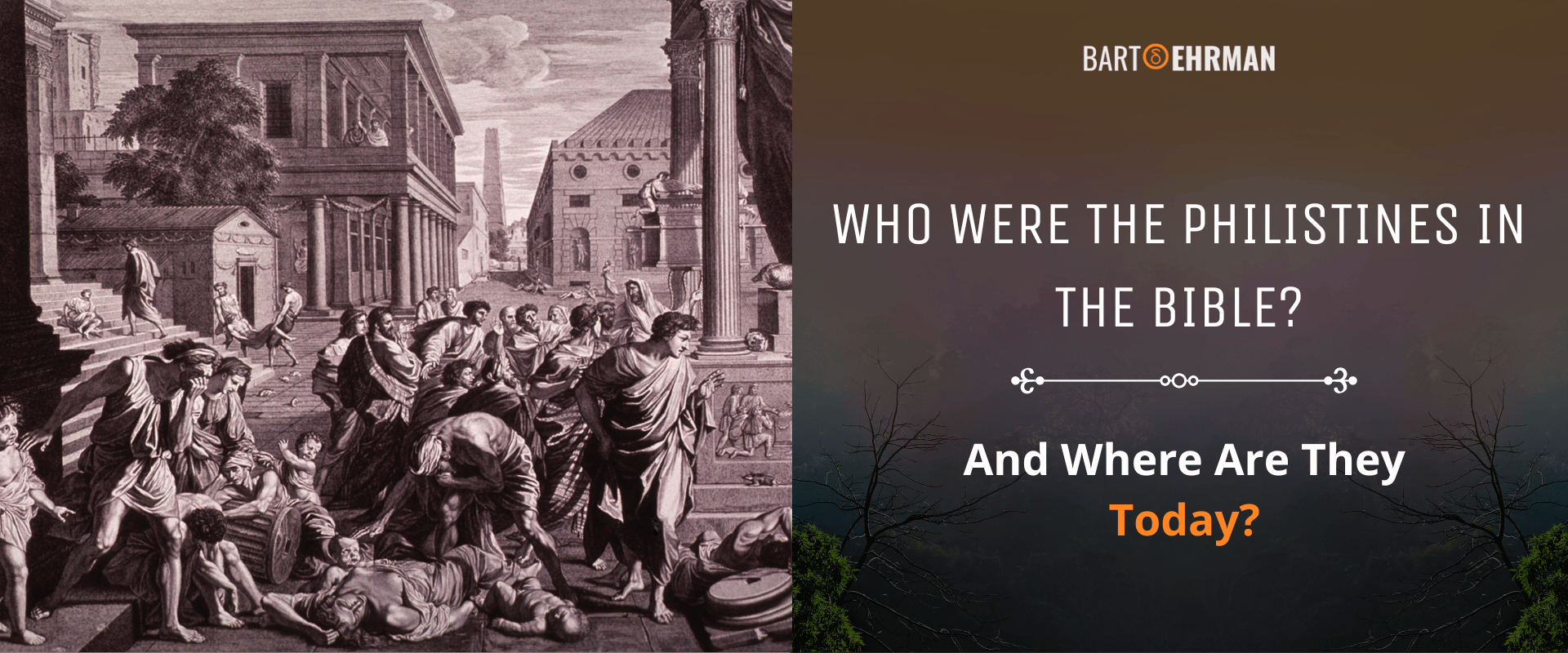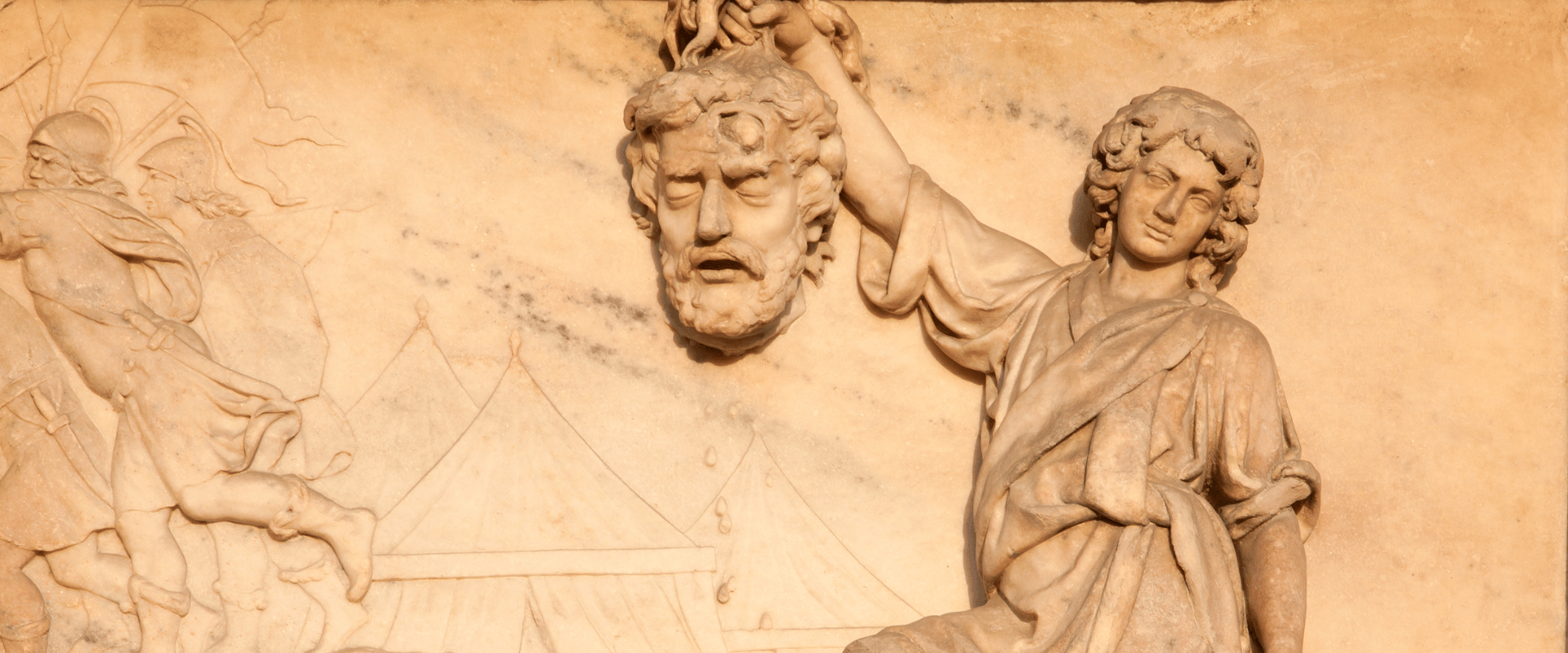Who Were the Philistines in the Bible? (And Where Are They Today?)

Written by Joshua Schachterle, Ph.D
Author | Professor | BE Contributor
Verified! See our editorial guidelines
Verified! See our guidelines
Disclaimer: The views and opinions expressed in this article belong to the author and do not necessarily match my own. - Dr. Bart D. Ehrman
Along with the Egyptians and the Babylonians, the Philistines were depicted as one of the most powerful enemies of Israel in the Old Testament. So who were the Philistines in the Bible?
They were portrayed as formidable military adversaries and unjust oppressors over Israel in the classic stories of Samson, King David, and others. So, given that the Hebrew Bible is not always historically accurate according to modern standards, what can we know about the Philistines? Were they a real people or merely convenient fictional foils for stories of Israel’s greatness?
In this article, I’ll address how the Philistines are depicted in the Hebrew Bible and what archeological evidence says about them.

What’s in a Name?
In the modern world, calling someone a “philistine” insinuates that they are uncultured or unrefined. Why did this meaning develop? As we will see, the Philistines, as they are characterized in the Hebrew Bible, are the nemeses (one of many) of the Israelites.
By the 17th century or so, when “philistine” became an insult in European countries, Christianity had long been the dominant religion in those countries. Since the Hebrew Bible was part of the Christian Bible, any enemies of the Israelites featured prominently in biblical stories came to be reviled (look at how the name “Jezebel” became an insult, for example).
Our word “Philistine” is an English version of the Hebrew Pəlištī (plural Pəlištīm). Other ancient Near East peoples made reference to them as well, with the Akkadians calling them Palastu and the Egyptians calling them Palusata.
How Does the Bible Characterize the Philistines?
The first biblical reference to the Philistines comes in Genesis 10:13-14 where there is a list of all the peoples who descended from Noah’s sons Shem, Ham, and Japheth after the great flood. Among those descended from Ham, we are told that “Egypt became the father of Ludim, Anamim, Lehabim, Naphtuhim, Pathrusim, Casluhim, from whom the Philistines come, and Caphtorim.”
It may be significant here that the Philistines are said to have descended from Noah’s son Ham. In the previous chapter of Genesis, there is a (admittedly weird) story where Noah gets drunk and passes out naked. Ham comes in and sees him and for this, Noah curses him and his descendants, starting with Ham’s son named Canaan.
The story is not historical, but it does offer a biblical explanation for why the Philistines, among many other peoples, were not favored by Israel’s God. However, this doesn’t mean that the Philistines were seen as weak or unsuccessful militarily. In fact, they are generally depicted as having a strong military which they use to encroach onto Israelite territory.
In Judges 13, for example, we are told that the Israelites had displeased God and had therefore been taken over by the Philistines who are portrayed as unjust despots. This is why Samson, the Israelite hero of this section of Judges, makes his individual war on them, killing a thousand with the jawbone of a donkey (Judges 15:14-17) and pulling their temple to the god Dagon down on top of them (Judges 16:28-31). Even though the Philistines are in power, these stories seem to say, God is with the Israelites.
Of course, the most famous biblical story involving the Philistines is that of David and Goliath in the book of 1 Samuel. There are several anecdotes preceding this story where Saul and his son Jonathan defeat small contingents of Philistines, only to discover that a larger Philistine force is amassing on their borders (see 1 Samuel 13:5-7).
This culminates in the emergence of a Philistine champion, a giant blowhard named Goliath (height about 6’ 9” according to the story!), who challenges the Israelites to send out their own champion to fight him. While this seems improbable, Goliath says that he will fight the Israelite champion individually, with the victor’s people gaining control over the other.
We can see in the figure of Goliath, the loudmouthed bully, by the way, the possible origin of our current use of the word “philistine” to mean someone lacking culture and sophistication.
When the young and relatively small David is able to defeat Goliath with one fling of his slingshot (Judges 17:41-49), it is further evidence from the biblical author that while the Israelites are God’s people, the Philistines remain God’s adversaries, a malevolent society against whom Israel will always prevail.
How much of this is historical? Were the Philistines a real people or merely a literary foil for the Israelites and others? Beyond the Hebrew Bible, do we have any evidence of their existence? To answer that, we need to look at the archeological record.
What Does Archeology Tell Us About the Philistines?
Amos 9:7 and several other places in the Hebrew Bible (Deuteronomy 2:23, Jeremiah 47:4) say that the Philistines originally came from a place called Caphtor. Based on ancient Egyptian inscriptions, scholars generally believe this to be the island of Crete.
Megan Sauter writes that in excavations at former Philistine sites, archeologists have discovered a striking similarity between Philistine material culture, such as pottery, tools, and weapons, and objects found in Cyprus and the region of the Aegean sea. This means that the Philistines brought aspects of their Greek and/or Minoan culture with them to the Near East. It also indicates that they were probably a seafaring people originally.
In fact, knowledge of their nautical beginnings comes from ancient records about the Philistines located in Egyptian inscriptions from the mortuary of the pharaoh Rameses III. These inscriptions say the Philistine people arrived by sea, attacking the Egyptian mainland around the 12th century BCE. They were eventually beaten back and settled into the land of Canaan along the Mediterranean coast.
Their cities included Ashdod, Ashkelon, Ekron, Gath, and Gaza. Several of these have been excavated, turning up evidence that the Philistines’ pottery, weapons, tools, and houses were quite distinct from those of the cultures around them. It’s also clear that they had massive trade networks.
The city of Ashkelon, for instance, was an important center for trade, because it was on the Via Maris, a trade route between Egypt, Syria, and Mesopotamia. There have been extensive archeological excavations in Ashkelon for decades, yielding vast information about the Philistines, including their material culture, religion, and economy.
After the Jews, led by the Maccabees, overthrew the Greek rulers in the 2nd century BCE, the city of Ashkelon became a kind of independent city state for a time. However, it was long ago incorporated into the borders of Palestine. It’s now a modern Israeli city built on and around the foundations of the old city on the Israeli coast.
Like Israel and Judah, the Philistines ultimately lost their sovereignty in the 6th century BCE. They were conquered and controlled, first by the Assyrians, then the Egyptians, and finally the Babylonians. The Babylonian king Nebuchadnezzar destroyed the cities of Ashkelon and Ekron and carried off many Philistines into exile. As Jeremiah 47:4-5 put it:
For the Lord is destroying the Philistines,
the remnant of the coastland of Caphtor.
Baldness has come upon Gaza;
Ashkelon is silenced.
What Was the Philistine Religion?
The evidence we have for Philistine religion seems to reveal that they had incorporated the deities of the Near East cultures surrounding them. The names of the deities they worshiped will sound familiar to anyone who’s read stories of them in the Hebrew Bible: Baal, Ashteroth (or Astarte), Asherah, and Dagon. None of these gods were of Greek or Cretan origin but were instead part of the Canaanite pantheon.
J.P. Emanuel notes that although the Bible says that the principal Philistine god was Dagon, there is little mention of Dagon in actual Philistine inscriptions. However, one aspect of their religion which may go back to their Greek origins is the female deity figurines frequently found in excavations in cities like Ashkelon. Unlike many Near-Eastern religious models, the dominance of a female deity may point back to the Philistines’ Greek origins.

Where Are They Now?
Since the decline of the Philistines as a military power and a distinct civilization, what has happened to them?
Among the finds in Ashkelon, archeologists like Daniel Masters have discovered some cemeteries ranging from the 11th to the 8th centuries BCE. They were able to analyze skeletal DNA from seven of the earliest individual burials and have discovered that the best genetic match for them indeed came from Crete.
However, DNA analysis of later burials shows a large amount of European DNA as well. According to Masters, by the 10th century BCE, the Philistines had intermarried with the people of surrounding civilizations enough that any distinction in their genetics was mostly gone.
Conclusion
Who were the Philistines? Despite the biblical caricatures of them as uncouth oppressors, often functioning only as foils for the Israelites (or instruments of punishment for Israel’s God), they were a unique civilization.
Both DNA and archeological evidence indicates that they came originally from Crete, bringing aspects of Greek and/or Minoan culture with them. This included material culture such as distinctive types of pottery and weapons that had parallels in Crete, and figurines of female deities.
Despite this, their pantheon was dominated by Canaanite gods such as Baal, Ashteroth, and Dagon, showing that as they intermarried with surrounding cultures they gradually adopted the religious practices and ideas of those cultures as well. The Philistines were definitely a real civilization, not just villains in the story of the Israelites. Whether they produced ill-mannered giants is much harder to prove.

